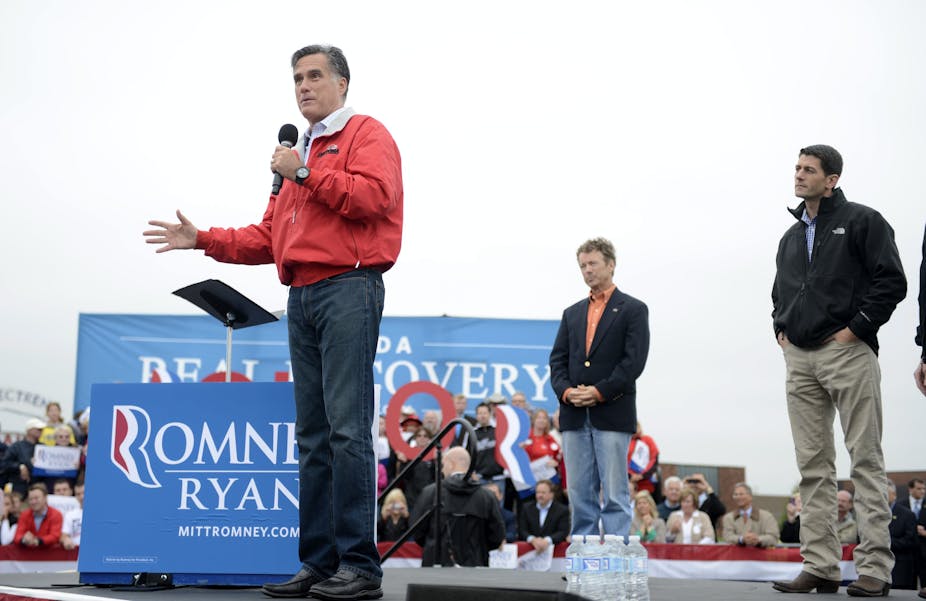It is about five weeks before the election and, overall, President Obama seems to hold a small but steady margin over Mitt Romney.
However, predictions regarding the popular vote are not as important as focusing on the swing states – a small group composed by, at least, Colorado, Florida, Iowa, Nevada, New Hampshire, North Carolina, Ohio, Virginia, and Wisconsin where neither Democrats nor Republicans hold a clear majority.
In a highly polarised political context, these will be the states that decide the election. Although a scenario like the one experienced in Bush v. Gore (2000), when the former won the presidency without winning the popular vote and by a minimal (and debatable) margin in the pivotal state of Florida, seems unlikely, there are still several ways in which Romney could win enough states to remain competitive and, possibly, even win the presidency.
In a series of articles beginning today, we will take a look at these “purple states”. We will start with the Western states of Colorado, Iowa and Nevada, which have similar dynamics but also some key differences. This analysis of the swing states should provide a primer for making sense of the results next month.
Colorado will host the first presidential debate this coming Wednesday. It is a fitting place: Obama carried the state (and its nine electoral votes) in 2008 by eight points. The state used to favour Republican presidential candidates in the past four decades, but demographic changes including an increase in the Hispanic population in urban and some rural areas, coupled with the arrival of new migrants (especially in the cities of Denver and Boulder), have turned it into the competitive turf of today.
Both contenders recognise the importance of the state – each of them has visited Colorado at least eight times since June, and campaign advertising has been rampant, even targeting communities outside the candidates’ comfort zone and spending close to $30 million in advertising. A key issue among centrist, independent voters within the state seems to be the economy, despite having performed relatively well in the past few years.
Though the latest polls seem to suggest that Obama is holding its ground against Romney, experts are cautious about making definitive predictions – for example, Larry Sabato considers the state a toss-up. With all these elements in mind, the coming debate should not be missed.
On the other hand, Iowa is a very interesting swing state. Here, the President seems to be a clear favourite: he won the state in 2008 by over nine points, and is now commanding a relatively comfortable seven point lead against Romney, according to the latest polls. Also good for Obama is that Iowans have already begun voting, thanks to new flexible rules that allow for early presidential voting, so Obama could start translating these “intentions” into actual votes. Democrats were apparently ready to seize this opportunity, outnumbering requests for absentee ballots in a whopping five-to-one ratio.

Yet, does this mean that Iowa’s six electoral votes are in Obama’s pocket? Well, not really. In this state, registered Republicans and Democrats are fairly evenly split. Thus, most voters are independent, non-registered citizens, many of which are still open to define their vote in the last few weeks (as the 2008 elections showed). On the other hand, the Republican base was highly mobilised for the primary caucuses through a large grassroots effort that could now play a key role in bringing voters to the polls on Election Day.
It will be interesting to see if Paul Ryan’s vice presidential nomination makes any difference for conservative voters and blue-collar workers and rural voters who are disgruntled with the economy: a dynamic similar to Wisconsin, now considered a safe state for Obama according to recent polls.
With regards to Nevada, the situation is a bit different. The state’s six electoral votes went to Obama in 2008 with a significant margin (12.5 points), building on changing demographics in the state - including a growing Hispanic vote, which has arguably become even larger this year. However, this time around the president seems to hold only a low single-digit advantage.
There, the biggest problem is the economy – the state still has abysmal foreclosure levels and high unemployment. In theory, this should favour Romney. However, recent polls suggest that voters are evenly split in terms of who they think would better handle the economy. It will be interesting to see if this changes with the coming weeks of heavy advertising and presidential debates.
Finally, we should point out that the Obama campaign so far is outspending Romney in all three states. Although the Obama campaign has less cash on hand than Romney’s, the Democrats have concentrated their resources in key battleground states, and have made efforts to keep their grassroots networks active.
Will this be enough to retain Obama’s small edge over Romney in these valuable states? Stay tuned.

